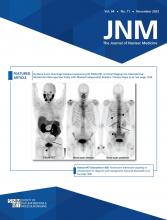REPLY: I extend my gratitude to Altena et al. for their insightful response to our letter to the editor (1) regarding human epidermal growth factor receptor 2 (HER2)–targeted PET imaging in breast cancer patients. It is with great enthusiasm that I acknowledge the pivotal role their work holds in propelling the field of nuclear medicine forward.
The pursuit of HER2-targeted therapies will probably transform the landscape of oncology, analogous to the paradigm shift brought about by HER2-targeted antibody–drug conjugates in HER2-positive and HER2-low metastatic breast cancer (with trastuzumab-deruxtecan as the best example right now) (2). Similarly, the introduction of HER2-targeted PET imaging could mark a vital turning point for the nuclear medicine community (3,4). This approach not only holds promise for metastatic breast cancer but also extends its implications to broader horizons, encompassing conditions such as gastroesophageal cancer and uterine carcinosarcoma (5,6).
Undoubtedly, their ongoing clinical trial entitled “[68Ga]Ga-ABY-025 PET for Quantification of HER2-Status in Solid Tumors” (ClinicalTrials.gov identifier NCT05619016) aligns perfectly with the pressing concerns of our time, bearing in mind developments with HER2-low as a novel category of breast cancer. These data will shed light on the potential of HER2-targeted PET imaging in addressing diagnostic and therapeutic challenges across a spectrum of solid tumors. The authors’ endeavors naturally resonate with the evolving therapeutic landscape, validating the need for precise and individualized treatment strategies.
In conclusion, I commend the authors for their pioneering work in the realm of HER2-targeted PET imaging. Their dedication holds the promise of reshaping how we approach diagnosis and treatment using PET imaging for breast cancer and beyond. It is my sincere hope that their research will serve as a cornerstone for innovation and collaboration in the field of nuclear medicine in oncology.
Seban Romain-David
Institut Curie
E-mail: romain.seban{at}gmail.com
Footnotes
Published online Sep. 14, 2023.
- © 2023 by the Society of Nuclear Medicine and Molecular Imaging.
- Revision received August 8, 2023.
- Accepted for publication August 22, 2023.







